0 简介
0.1 主题



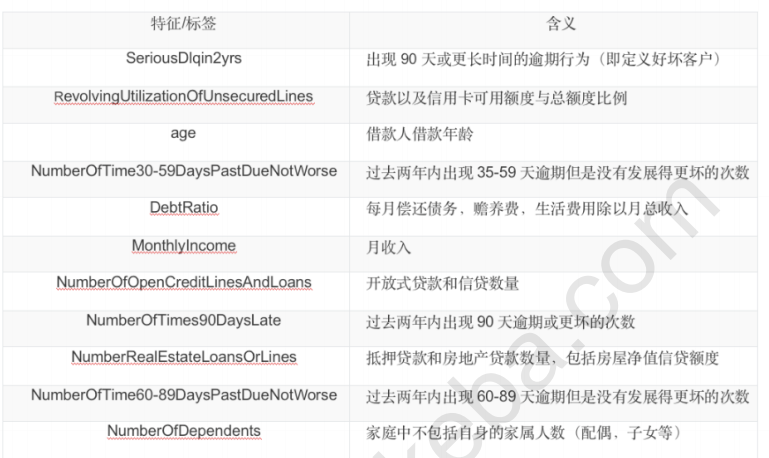
0.2 目标

1 探索数据
1.1 导库/获取数据
%matplotlib inline import numpy as np import pandas as pd
data = pd.read_csv(r"Acard.csv",index_col=0) #观察数据类型 data.head()
#观察数据结构 data.shape
(150000, 11)
data.info()
<class 'pandas.core.frame.DataFrame'> Int64Index: 150000 entries, 1 to 150000 Data columns (total 11 columns): SeriousDlqin2yrs 150000 non-null int64 RevolvingUtilizationOfUnsecuredLines 150000 non-null float64 age 150000 non-null int64 NumberOfTime30-59DaysPastDueNotWorse 150000 non-null int64 DebtRatio 150000 non-null float64 MonthlyIncome 120269 non-null float64 NumberOfOpenCreditLinesAndLoans 150000 non-null int64 NumberOfTimes90DaysLate 150000 non-null int64 NumberRealEstateLoansOrLines 150000 non-null int64 NumberOfTime60-89DaysPastDueNotWorse 150000 non-null int64 NumberOfDependents 146076 non-null float64 dtypes: float64(4), int64(7) memory usage: 13.7 MB
1.2 去重复值
data.drop_duplicates(inplace=True)
<class 'pandas.core.frame.DataFrame'> Int64Index: 149391 entries, 1 to 150000 Data columns (total 11 columns): SeriousDlqin2yrs 149391 non-null int64 RevolvingUtilizationOfUnsecuredLines 149391 non-null float64 age 149391 non-null int64 NumberOfTime30-59DaysPastDueNotWorse 149391 non-null int64 DebtRatio 149391 non-null float64 MonthlyIncome 120170 non-null float64 NumberOfOpenCreditLinesAndLoans 149391 non-null int64 NumberOfTimes90DaysLate 149391 non-null int64 NumberRealEstateLoansOrLines 149391 non-null int64 NumberOfTime60-89DaysPastDueNotWorse 149391 non-null int64 NumberOfDependents 145563 non-null float64 dtypes: float64(4), int64(7) memory usage: 13.7 MB
data.index = range(data.shape[0])
data.info()
<class 'pandas.core.frame.DataFrame'> RangeIndex: 149391 entries, 0 to 149390 Data columns (total 11 columns): SeriousDlqin2yrs 149391 non-null int64 RevolvingUtilizationOfUnsecuredLines 149391 non-null float64 age 149391 non-null int64 NumberOfTime30-59DaysPastDueNotWorse 149391 non-null int64 DebtRatio 149391 non-null float64 MonthlyIncome 120170 non-null float64 NumberOfOpenCreditLinesAndLoans 149391 non-null int64 NumberOfTimes90DaysLate 149391 non-null int64 NumberRealEstateLoansOrLines 149391 non-null int64 NumberOfTime60-89DaysPastDueNotWorse 149391 non-null int64 NumberOfDependents 145563 non-null float64 dtypes: float64(4), int64(7) memory usage: 12.5 MB
1.3 填补缺失值
data.isnull().sum()/data.shape[0] # data.isnull().mean()
SeriousDlqin2yrs 0.000000 RevolvingUtilizationOfUnsecuredLines 0.000000 age 0.000000 NumberOfTime30-59DaysPastDueNotWorse 0.000000 DebtRatio 0.000000 MonthlyIncome 0.195601 NumberOfOpenCreditLinesAndLoans 0.000000 NumberOfTimes90DaysLate 0.000000 NumberRealEstateLoansOrLines 0.000000 NumberOfTime60-89DaysPastDueNotWorse 0.000000 NumberOfDependents 0.025624 dtype: float64
data["NumberOfDependents"].fillna(int(data["NumberOfDependents"].mean()),inplace=True) data.isnull().sum()/data.shape[0]
SeriousDlqin2yrs 0.000000 RevolvingUtilizationOfUnsecuredLines 0.000000 age 0.000000 NumberOfTime30-59DaysPastDueNotWorse 0.000000 DebtRatio 0.000000 MonthlyIncome 0.195601 NumberOfOpenCreditLinesAndLoans 0.000000 NumberOfTimes90DaysLate 0.000000 NumberRealEstateLoansOrLines 0.000000 NumberOfTime60-89DaysPastDueNotWorse 0.000000 NumberOfDependents 0.000000 dtype: float64
def fill_missing_rf(X, y, to_fill): """ X:要填补的特征矩阵 y:完整的,没有缺失值的标签 to_fill:字符串,要填补的那一列的名称/MonthlyIncome """ # 构建新特征矩阵和新标签 df = X.copy() fill = df.loc[:, to_fill] df = pd.concat([df.loc[:, df.columns != to_fill], pd.DataFrame(y)], axis=1) #找出训练集和测试集 Ytrain = fill[fill.notnull()] Ytest = fill[fill.isnull()] Xtrain = df.iloc[Ytrain.index, :] Xtest = df.iloc[Ytest.index, :] from sklearn.ensemble import RandomForestRegressor as rfr #用随机森林回归来填补缺失值 rfr = rfr(n_estimators=100) rfr = rfr.fit(Xtrain, Ytrain) Ypredict = rfr.predict(Xtest) return Ypredict
X = data.iloc[:,1:] y = data["SeriousDlqin2yrs"] y_pred = fill_missing_rf(X,y,"MonthlyIncome") #确认我们的结果合理之后,我们就可以将数据覆盖了 data.loc[data.loc[:,"MonthlyIncome"].isnull(),"MonthlyIncome"] = y_pred
y_pred.shape
(29221,)
2 描述性统计
2.1 处理异常值
import seaborn as sns from matplotlib import pyplot as plt x1=data['age'] fig,axes = plt.subplots() axes.boxplot(x1) axes.set_xticklabels(['age']) data = data[data['age']>0] data = data[data['age']<100]

data = data[data["age"] != 0] data.shape
(149377, 11)
data.describe([0.01,0.1,0.25,.5,.75,.9,.99]) (data["age"] == 0).sum() data = data[data["age"] != 0] data[data.loc[:,"NumberOfTimes90DaysLate"] > 90].count() data = data[data.loc[:,"NumberOfTimes90DaysLate"] < 90] data.index = range(data.shape[0]) data.info()
<class 'pandas.core.frame.DataFrame'> RangeIndex: 149152 entries, 0 to 149151 Data columns (total 11 columns): SeriousDlqin2yrs 149152 non-null int64 RevolvingUtilizationOfUnsecuredLines 149152 non-null float64 age 149152 non-null int64 NumberOfTime30-59DaysPastDueNotWorse 149152 non-null int64 DebtRatio 149152 non-null float64 MonthlyIncome 149152 non-null float64 NumberOfOpenCreditLinesAndLoans 149152 non-null int64 NumberOfTimes90DaysLate 149152 non-null int64 NumberRealEstateLoansOrLines 149152 non-null int64 NumberOfTime60-89DaysPastDueNotWorse 149152 non-null int64 NumberOfDependents 149152 non-null float64 dtypes: float64(4), int64(7) memory usage: 12.5 MB
2.2 处理样本不均衡问题
#探索标签的分布 X = data.iloc[:,1:] y = data.iloc[:,0] y.value_counts() n_sample = X.shape[0] n_1_sample = y.value_counts()[1] n_0_sample = y.value_counts()[0] grouped = data['SeriousDlqin2yrs'].groupby(data['SeriousDlqin2yrs']).count() grouped.plot(kind='bar') print('样本个数:{}; 1占{:.2%}; 0占 {:.2%}'.format(n_sample,n_1_sample/n_sample,n_0_sample/n_sample))
样本个数:149152; 1占6.62%; 0占 93.38%

from imblearn.over_sampling import SMOTE #conda install -c glemaitre imbalanced-learn import imblearn from imblearn.over_sampling import SMOTE sm = SMOTE(random_state=42) #实例化 X,y = sm.fit_sample(X,y)
n_sample_ = X.shape[0] pd.Series(y).value_counts() n_1_sample = pd.Series(y).value_counts()[1] n_0_sample = pd.Series(y).value_counts()[0] print('样本个数:{}; 1占{:.2%}; 0占{:.2%}'.format(n_sample_,n_1_sample/n_sample_,n_0_sample/n_sample_))
样本个数:278560; 1占50.00%; 0占50.00%
2.3 训练集和测试集
from sklearn.model_selection import train_test_split X = pd.DataFrame(X) y = pd.DataFrame(y) X_train, X_vali, Y_train, Y_vali = train_test_split(X,y,test_size=0.3,random_state=420) model_data = pd.concat([Y_train, X_train], axis=1) model_data.index = range(model_data.shape[0]) model_data.columns = data.columns vali_data = pd.concat([Y_vali, X_vali], axis=1) vali_data.index = range(vali_data.shape[0]) vali_data.columns = data.columns model_data.to_csv(r"model_data.csv") vali_data.to_csv(r"C:vali_data.csv")
3 分箱处理
3.1 等频分箱
#retbins 默认为False,为True是返回值是元组 #q:分组个数 model_data["qcut"], updown = pd.qcut(model_data["age"], retbins=True, q=20) coount_y0 = model_data[model_data["SeriousDlqin2yrs"] == 0].groupby(by="qcut").count() ["SeriousDlqin2yrs"] coount_y1 = model_data[model_data["SeriousDlqin2yrs"] == 1].groupby(by="qcut").count() ["SeriousDlqin2yrs"] #num_bins值分别为每个区间的上界,下界,0出现的次数,1出现的次数 num_bins = [*zip(updown,updown[1:],coount_y0,coount_y1)] #注意zip会按照最短列来进行结合 num_bins
[(21.0, 28.0, 4232, 7592), (28.0, 31.0, 3534, 5838), (31.0, 34.0, 4045, 6813), (34.0, 36.0, 2925, 4710), (36.0, 39.0, 5269, 7570), (39.0, 41.0, 3977, 5667), (41.0, 43.0, 4044, 5644), (43.0, 45.0, 4404, 6003), (45.0, 46.0, 2345, 3258), (46.0, 48.0, 4851, 6366), (48.0, 50.0, 4882, 6164), (50.0, 52.0, 4658, 5796), (52.0, 54.0, 4661, 4885), (54.0, 56.0, 4507, 4071), (56.0, 58.0, 4525, 3475), (58.0, 61.0, 6662, 4841), (61.0, 64.0, 6959, 3132), (64.0, 68.0, 6608, 2309), (68.0, 74.0, 6776, 1939), (74.0, 99.0, 7703, 1352)]
model_data.head()
3.2 封装WOE和IV函数





def get_woe(num_bins): columns = ["min","max","count_0","count_1"] df = pd.DataFrame(num_bins,columns=columns) df["total"] = df.count_0 + df.count_1 df["percentage"] = df.total / df.total.sum() df["bad_rate"] = df.count_1 / df.total df["good%"] = df.count_0/df.count_0.sum() df["bad%"] = df.count_1/df.count_1.sum() df["woe"] = np.log(df["good%"] / df["bad%"]) return df # 计算IV值 def get_iv(df): rate = df["good%"] - df["bad%"] iv = np.sum(rate * df.woe) return iv
3.3 用卡方检验来合并箱体画出IV曲线
num_bins_ = num_bins.copy() import matplotlib.pyplot as plt import scipy IV = [] axisx = [] while len(num_bins_) > 2: pvs = [] for i in range(len(num_bins_) - 1): x1 = num_bins_[i][2:] x2 = num_bins_[i + 1][2:] pv = scipy.stats.chi2_contingency([x1, x2])[1] pvs.append(pv) i = pvs.index(max(pvs)) num_bins_[i:i + 2] = [(num_bins_[i][0],num_bins_[i+1][1],num_bins_[i][2]+num_bins_[i+1][2],num_bins_[i][3]+num_bins_[i+1][3])] bins_df = get_woe(num_bins_) axisx.append(len(num_bins_)) IV.append(get_iv(bins_df)) plt.figure() plt.plot(axisx, IV) plt.xticks(axisx) plt.xlabel("number of box") plt.ylabel("IV") plt.show()

3.4 用最佳分箱个数分箱,并验证分箱结果
def graphforbestbin(DF, X, Y, n=5,q=20,graph=True): DF = DF[[X,Y]].copy() DF["qcut"],bins = pd.qcut(DF[X],retbins=True,q=q,duplicates="drop") coount_y0 = DF.loc[DF[Y]==0].groupby(by="qcut").count()[Y] coount_y1 = DF.loc[DF[Y]==1].groupby(by="qcut").count()[Y] num_bins = [*zip(bins,bins[1:],coount_y0,coount_y1)] # 确保每个箱中都有0和1 for i in range(q): if 0 in num_bins[0][2:]: num_bins[0:2] = [(num_bins[0][0],num_bins[1][1],num_bins[0][2]+num_bins[1][2],num_bins[0][3]+num_bins[1][3])] continue for i in range(len(num_bins)): if 0 in num_bins[i][2:]: num_bins[i-1:i+1] = [(num_bins[i-1][0],num_bins[i][1],num_bins[i-1][2]+num_bins[i][2],num_bins[i-1][3]+num_bins[i][3])] break else: break #计算WOE def get_woe(num_bins): columns = ["min","max","count_0","count_1"] df = pd.DataFrame(num_bins,columns=columns) df["total"] = df.count_0 + df.count_1 df["good%"] = df.count_0/df.count_0.sum() df["bad%"] = df.count_1/df.count_1.sum() df["woe"] = np.log(df["good%"] / df["bad%"]) return df #计算IV值 def get_iv(df): rate = df["good%"] - df["bad%"] iv = np.sum(rate * df.woe) return iv # 卡方检验,合并分箱 IV = [] axisx = [] while len(num_bins) > n: global bins_df pvs = [] for i in range(len(num_bins)-1): x1 = num_bins[i][2:] x2 = num_bins[i+1][2:] pv = scipy.stats.chi2_contingency([x1,x2])[1] pvs.append(pv) i = pvs.index(max(pvs)) num_bins[i:i+2] = [(num_bins[i][0],num_bins[i+1][1],num_bins[i][2]+num_bins[i+1][2],num_bins[i][3]+num_bins[i+1][3])] bins_df = pd.DataFrame(get_woe(num_bins)) axisx.append(len(num_bins)) IV.append(get_iv(bins_df)) if graph: plt.figure() plt.plot(axisx,IV) plt.xticks(axisx) plt.xlabel("number of box") plt.ylabel("IV") plt.show() return bins_df
model_data.columns
Index(['SeriousDlqin2yrs', 'RevolvingUtilizationOfUnsecuredLines', 'age',
'NumberOfTime30-59DaysPastDueNotWorse', 'DebtRatio', 'MonthlyIncome',
'NumberOfOpenCreditLinesAndLoans', 'NumberOfTimes90DaysLate',
'NumberRealEstateLoansOrLines', 'NumberOfTime60-89DaysPastDueNotWorse',
'NumberOfDependents', 'qcut'],
dtype='object')
for i in model_data.columns[1:-1]: print(i) graphforbestbin(model_data,i ,"SeriousDlqin2yrs",n=2,q = 20)


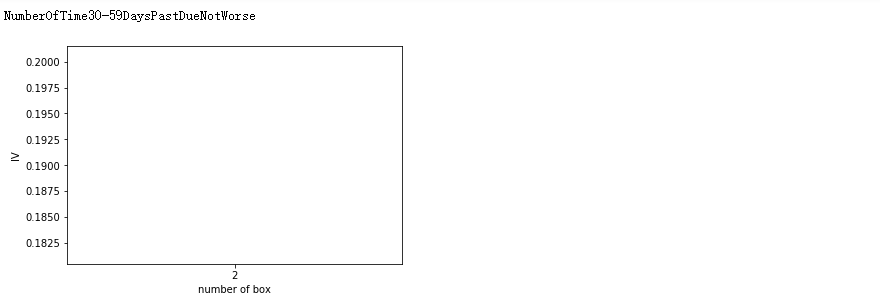
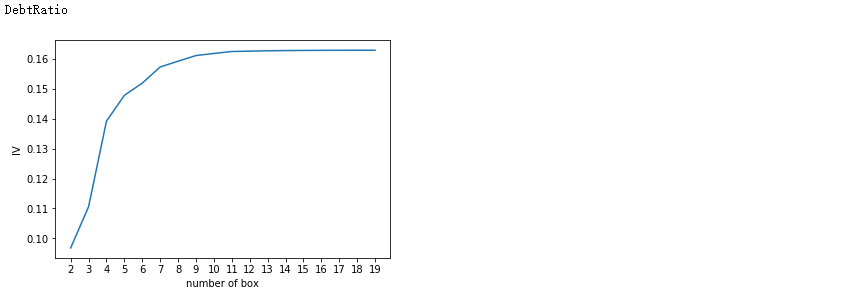
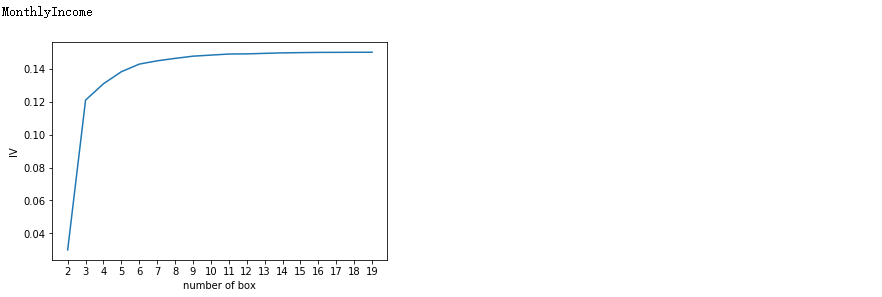

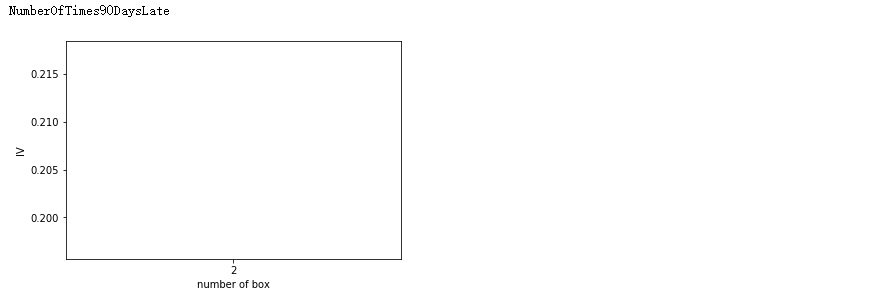



auto_bins = {'RevolvingUtilizationOfUnsecuredLines':5
,'age':6
,'DebtRatio':4
,'MonthlyIncome':3
,'NumberOfOpenCreditLinesAndLoans':7
}
hand_bins = {'NumberOfTime30-59DaysPastDueNotWorse':[0,1,2,13]
,'NumberOfTimes90DaysLate':[0,1,2,17]
,'NumberRealEstateLoansOrLines':[0,1,2,4,54]
,'NumberOfTime60-89DaysPastDueNotWorse':[0,1,2,8]
,'NumberOfDependents':[0,1,2,3]
}
hand_bins = {k:[-np.inf,*v[:-1],np.inf] for k,v in hand_bins.items()}
bins_of_col = {}
for col in auto_bins:
bins_df = graphforbestbin(model_data,col,'SeriousDlqin2yrs',n = auto_bins[col],q=20,graph=False)
bins_list = sorted(set(bins_df['min']).union(bins_df['max']))
bins_list[0],bins_list[-1] = -np.inf,np.inf
bins_of_col[col] = bins_list
bins_of_col.update(hand_bins)
bins_of_col
{'RevolvingUtilizationOfUnsecuredLines': [-inf,
0.0601572472,
0.2967246438,
0.5513223325011126,
0.9999998999999999,
inf],
'age': [-inf, 36.0, 52.0, 56.0, 61.0, 74.0, inf],
'DebtRatio': [-inf,
0.01746415575,
0.3199668078059851,
1.5117839943256448,
inf],
'MonthlyIncome': [-inf, 0.09903188507757776, 5600.0, inf],
'NumberOfOpenCreditLinesAndLoans': [-inf, 1.0, 2.0, 3.0, 5.0, 6.0, 17.0, inf],
'NumberOfTime30-59DaysPastDueNotWorse': [-inf, 0, 1, 2, inf],
'NumberOfTimes90DaysLate': [-inf, 0, 1, 2, inf],
'NumberRealEstateLoansOrLines': [-inf, 0, 1, 2, 4, inf],
'NumberOfTime60-89DaysPastDueNotWorse': [-inf, 0, 1, 2, inf],
'NumberOfDependents': [-inf, 0, 1, 2, inf]}
4 计算各箱的WOE并映射到数据
data = model_data.copy() data = data[["age","SeriousDlqin2yrs"]].copy() data["cut"] = pd.cut(data["age"],[-np.inf, 36.0, 52.0, 56.0, 61.0, 74.0, np.inf]) data
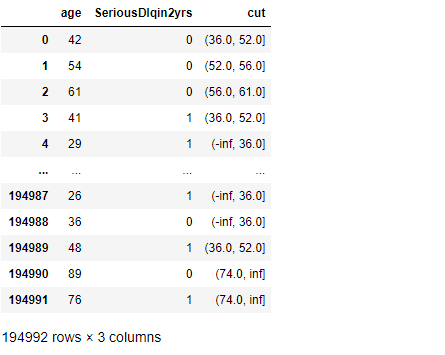
#将数据按分箱结果聚合,并取出其中的标签值 data.groupby("cut")["SeriousDlqin2yrs"].value_counts() #使用unstack()来将分支状结构变成表状结构 data.groupby("cut")["SeriousDlqin2yrs"].value_counts().unstack() bins_df = data.groupby("cut")["SeriousDlqin2yrs"].value_counts().unstack() bins_df["woe"] = np.log((bins_df[0]/bins_df[0].sum())/(bins_df[1]/bins_df[1].sum()))
bins_df

# df:数据表 # col:列 # bins:箱子的个数 def get_woe(df,col,y,bins): df = df[[col,y]].copy() df["cut"] = pd.cut(df[col],bins) bins_df = df.groupby("cut")[y].value_counts().unstack() woe = bins_df["woe"] = np.log((bins_df[0]/bins_df[0].sum())/(bins_df[1]/bins_df[1].sum())) iv = np.sum((bins_df[0]/bins_df[0].sum()-bins_df[1]/bins_df[1].sum())*bins_df['woe']) return woe
# 所有的WOE woeall = {} for col in bins_of_col: woeall[col] = get_woe(model_data,col,"SeriousDlqin2yrs",bins_of_col[col]) woeall
{'RevolvingUtilizationOfUnsecuredLines': cut
(-inf, 0.0602] 2.454528
(0.0602, 0.297] 0.854575
(0.297, 0.551] -0.255194
(0.551, 1.0] -1.009565
(1.0, inf] -2.043275
dtype: float64, 'age': cut
(-inf, 36.0] -0.528157
(36.0, 52.0] -0.301292
(52.0, 56.0] 0.021939
(56.0, 61.0] 0.295115
(61.0, 74.0] 1.012507
(74.0, inf] 1.738568
dtype: float64, 'DebtRatio': cut
(-inf, 0.0175] 1.476452
(0.0175, 0.32] 0.079382
(0.32, 1.512] -0.312205
(1.512, inf] 0.167100
dtype: float64, 'MonthlyIncome': cut
(-inf, 0.099] 1.255267
(0.099, 5600.0] -0.229847
(5600.0, inf] 0.237632
dtype: float64, 'NumberOfOpenCreditLinesAndLoans': cut
(-inf, 1.0] -0.857776
(1.0, 2.0] -0.418703
(2.0, 3.0] -0.255258
(3.0, 5.0] -0.060634
(5.0, 6.0] 0.077346
(6.0, 17.0] 0.137661
(17.0, inf] 0.443648
dtype: float64, 'NumberOfTime30-59DaysPastDueNotWorse': cut
(-inf, 0.0] 0.353740
(0.0, 1.0] -0.870009
(1.0, 2.0] -1.378862
(2.0, inf] -1.540042
dtype: float64, 'NumberOfTimes90DaysLate': cut
(-inf, 0.0] 0.236664
(0.0, 1.0] -1.749395
(1.0, 2.0] -2.288567
(2.0, inf] -2.482175
dtype: float64, 'NumberRealEstateLoansOrLines': cut
(-inf, 0.0] -0.399029
(0.0, 1.0] 0.198435
(1.0, 2.0] 0.636290
(2.0, 4.0] 0.374777
(4.0, inf] -0.317472
dtype: float64, 'NumberOfTime60-89DaysPastDueNotWorse': cut
(-inf, 0.0] 0.124823
(0.0, 1.0] -1.411050
(1.0, 2.0] -1.746467
(2.0, inf] -1.742166
dtype: float64, 'NumberOfDependents': cut
(-inf, 0.0] 0.625336
(0.0, 1.0] -0.588620
(1.0, 2.0] -0.530037
(2.0, inf] -0.472481
dtype: float64}
model_woe = pd.DataFrame(index=model_data.index) for col in bins_of_col: model_woe[col] = pd.cut(model_data[col],bins_of_col[col]).map(woeall[col]) model_woe["SeriousDlqin2yrs"] = model_data["SeriousDlqin2yrs"] model_woe #这就是建模数据
5 建模与模型验证
woeall_vali = {} for col in bins_of_col: woeall_vali[col] = get_woe(vali_data,col,"SeriousDlqin2yrs",bins_of_col[col]) # 测试数据 vali_woe = pd.DataFrame(index=vali_data.index) for col in bins_of_col: vali_woe[col] = pd.cut(vali_data[col],bins_of_col[col]).map(woeall_vali[col]) vali_woe["SeriousDlqin2yrs"] = vali_data["SeriousDlqin2yrs"] vali_x = vali_woe.iloc[:,:-1] vali_y = vali_woe.iloc[:,-1]
from sklearn.linear_model import LogisticRegression as LR # 训练集 x = model_woe.iloc[:,:-1] y = model_woe.iloc[:,-1] lr = LR().fit(x,y) lr.score(vali_x,vali_y)
0.7838407045759143
c_1 = np.linspace(0.01,1,20) c_2 = np.linspace(0.01,0.2,20) score = [] for i in c_1: lr = LR(solver="liblinear",C = i).fit(x,y) score.append(lr.score(vali_x,vali_y)) plt.figure() plt.plot(c_1,score) plt.show()

import warnings warnings.filterwarnings('ignore') score = [] for i in [1,2,3,4,5,6]: lr = LR(solver="liblinear" ,C = 0.025 , max_iter=i).fit(x,y) score.append(lr.score(vali_x , vali_y)) plt.figure() plt.plot([1,2,3,4,5,6],score) plt.show()

import scikitplot as skplt #pip install scikit-plot vali_proba_df = pd.DataFrame(lr.predict_proba(vali_x)) skplt.metrics.plot_roc(vali_y, vali_proba_df, plot_micro=False,figsize=(6,6),plot_macro=False)
<matplotlib.axes._subplots.AxesSubplot at 0x1a2b3f92d0>
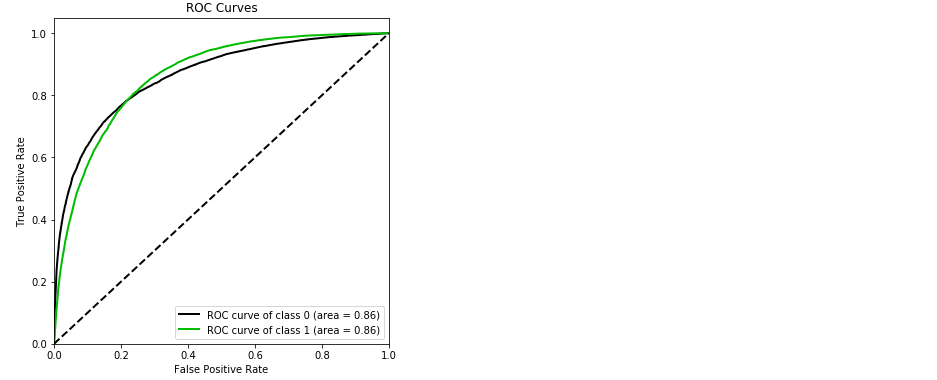
6 制作评分卡

B = 20/np.log(2)
A = 600 + B*np.log(1/60)
B ,A
(28.85390081777927, 481.8621880878296)
base_score = A - B*lr.intercept_
base_score
array([481.84554281])
score_age = woeall["age"] * (-B*lr.coef_[0][0]) score_age
cut (-inf, 36.0] -11.413547 (36.0, 52.0] -6.510964 (52.0, 56.0] 0.474105 (56.0, 61.0] 6.377466 (61.0, 74.0] 21.880412 (74.0, inf] 37.570705 dtype: float64
file = "ScoreData.csv" with open(file,"w") as fdata: fdata.write("base_score,{} ".format(base_score)) for i,col in enumerate(x.columns): score = woeall[col] * (-B*lr.coef_[0][i]) score.name = "Score" score.index.name = col score.to_csv(file,header=True,mode="a")
7 总结
